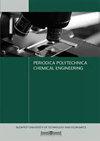混合氧化物基TiO2对壳聚糖薄膜理化性能的影响
IF 1.8
4区 工程技术
Q3 ENGINEERING, CHEMICAL
引用次数: 2
摘要
单独壳聚糖基薄膜(CS)或含有混合氧化物纳米粒子(TiO2-ZnO-MgO, TZM;不同浓度(125、250和500 μg mL−1)的CSTZM进行了研究。纳米tzm的加入促进了成膜液的颜色变化(由无色变为白色),增加了成膜液的浊度,降低了成膜液的粘度。CSTZM薄膜是半透明的(透光率,T%比cs基薄膜(T% = 95.5)降低了49%)。CSTZM(特别是当浓度为500 μg mL−1时)的含水率(从12.6%降低到9.67%)、水溶性(从14.94降低到10.22%)、溶胀度(从19.79提高到36.28%)、水蒸气阻隔性(从6.62 × 10−16 g m−1 h−1 Pa−1)、热稳定性(恒温峰从99.5°C提高到157.7°C)、力学性能(抗拉强度和断裂伸长率分别从4.15和6.96提高到4.98 kPa和56.18%,弹性模量从144 kPa降低到4.11 kPa),对盐蒿无毒性作用(存活率为93.33%)。x射线衍射和傅里叶变换红外研究证明了cs基薄膜与纳米tzm之间的相互作用。总的来说,这种薄膜在各种工业应用中表现出巨大的潜力。本文章由计算机程序翻译,如有差异,请以英文原文为准。
Effect of Mixed Oxide-Based TiO2 on the Physicochemical Properties of Chitosan Films
The physicochemical, mechanical, and structural properties of chitosan-based films (CS) alone or CS-films with mixed oxide nanoparticles (TiO2-ZnO-MgO, TZM; CSTZM) at different concentrations (125, 250, and 500 μg mL−1) were investigated. The addition of nano-TZM promoted a color change (from colorless to white) in the film-forming solution, which increased its turbidity and it decreased viscosity. CSTZM were semitransparent (transmittance, T% decreased up to 49%) compared to CS-based films (T% = 95.5). CSTZM (particularly at a concentration of 500 μg mL−1) exhibited an improvement in the moisture content (decreased from 12.6 to 9.67%), water solubility (decreased from 14.94 to 10.22%), degree of swelling (increased from 19.79 to 36.28%), water vapor barrier (decreased from 6.62 x 10−16 to 4.33 x 10−16 g m−1 h−1 Pa−1), thermal stability (the endotherm peak increased from 99.5 to 157.7 °C), and mechanical properties (tensile strength and elongation at break increased from 4.15 to 4.98 kPa and 6.96 to 56.18%, respectively, while the modulus of elasticity decreased from 144 kPa to 4.11 kPa), without toxicity effects on Artemia salina (93.33% survival). X-ray diffraction and Fourier transform infrared studies demonstrated an interaction between CS-based films and nano-TZM. Overall, this film exhibited great potential for diverse industrial applications.
求助全文
通过发布文献求助,成功后即可免费获取论文全文。
去求助
来源期刊

Periodica Polytechnica Chemical Engineering
ENGINEERING, CHEMICAL-
CiteScore
3.10
自引率
7.70%
发文量
44
审稿时长
>12 weeks
期刊介绍:
The main scope of the journal is to publish original research articles in the wide field of chemical engineering including environmental and bioengineering.
 求助内容:
求助内容: 应助结果提醒方式:
应助结果提醒方式:


